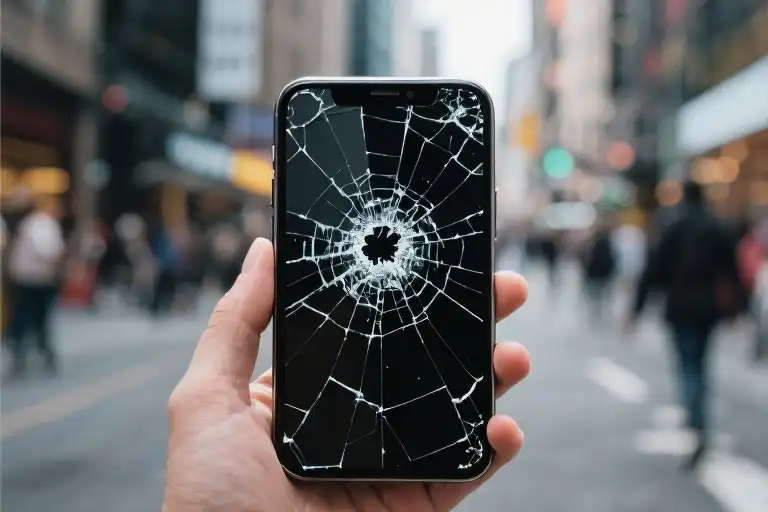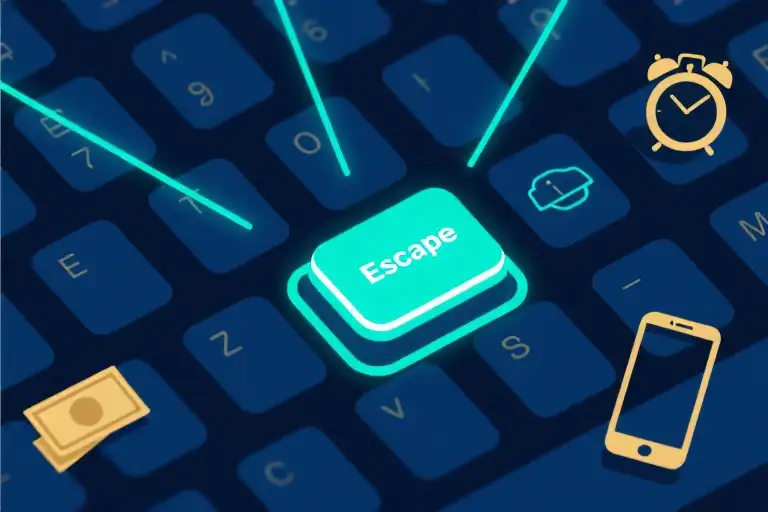The subway doors slide open with a hydraulic sigh, revealing a scene now as familiar as it is unsettling: rows of passengers standing shoulder-to-shoulder, each cocooned in their own glowing rectangle of light. A teenager taps rapidly between TikTok dances while his mother refreshes work emails. Across the aisle, a woman in her twenties scrolls through dating apps with the mechanical precision of a slot machine addict. Not a single pair of eyes meets another human face.
This isn’t just rush hour—it’s our new baseline. Recent studies show 28% of American adults now exist in a state of being “almost constantly” online, with half of young adults (18-29) living perpetually tethered to their devices. We’ve achieved unprecedented connectivity, yet surveys reveal record levels of loneliness and dissatisfaction. Which begs the uncomfortable question we’ve been avoiding: In our hunger for digital connection, have we accidentally traded away our happiness?
The irony stings. These pocket-sized portals promise community and knowledge, yet correlate strongly with deteriorating mental health—particularly for younger users. Research indicates 25.9% of teens logging four+ daily screen hours experience depression symptoms, with 27.1% reporting anxiety. Like invisible secondhand smoke, the psychological toll accumulates quietly until the damage becomes undeniable.
What makes these statistics particularly alarming is their dose-dependent nature. Internet use exceeding three hours daily pushes adolescents into the “very severe” depression range—a clear threshold effect most parents never see coming. Adults fare no better; our always-on work cultures and endless scroll habits create identical risk patterns across generations.
Yet before we condemn our smartphones and flee to digital Amish country, consider this paradox: The same platforms draining our joy also deliver genuine connection, education, and opportunity. The problem isn’t the technology—it’s how we’ve allowed it to reshape our behaviors, relationships, and even our brain chemistry without conscious consent.
As the train lurches forward, I watch reflected rectangles of light dance across the windows—hundreds of individual screens collectively painting our shared reality. The solution won’t be found in rejection or surrender, but in relearning how to hold these powerful tools without letting them hold us hostage. Because somewhere between digital detox and doomscrolling lies a third path: one where we control our screen time instead of letting it control us.
The Red Flags in the Data
Recent studies reveal alarming connections between screen time and mental health, with clear thresholds emerging that every parent and digital citizen should know. Among teenagers, those who spend four or more hours daily on screens show depression symptoms at 25.9% and anxiety at 27.1% – rates nearly double their peers with limited screen exposure.
The 3-Hour Tipping Point
A striking pattern emerges when examining internet usage duration:
- Below 2 hours/day: Minimal mental health impact
- 2-3 hours/day: Moderate risk increase
- Beyond 3 hours: Adolescents enter the “very severe” depression range
This dose-response relationship holds particular significance for young adults (18-29), where 50% now report being “almost constantly” online according to Pew Research data. The 28% figure among all American adults masks a generational divide that’s reshaping our social fabric.
Global Perspectives on Screen Culture
While Western nations grapple with “doomscrolling” behaviors, Eastern digital ecosystems show distinct patterns:
- East Asia: Higher educational screen time but stronger cultural norms around offline socializing
- Scandinavia: Later tech adoption in childhood correlating with lower teen anxiety rates
- U.S. Trends: 63% increase in therapeutic screen time (remote learning) since 2020
What makes these numbers particularly compelling is their consistency across multiple longitudinal studies. Like blood pressure readings indicating cardiovascular risk, screen duration now serves as a measurable vital sign for digital wellbeing.
The data doesn’t lie – when screen time crosses the 3-4 hour daily threshold, we’re no longer talking about moderate effects but significant mental health consequences. This understanding forms the foundation for developing effective screen time limits and digital detox strategies.
How Our Brain’s Reward System Gets Hijacked by Screens
That moment when you tell yourself “just one more video” at 2 AM, only to realize you’ve been scrolling mindlessly for hours? You’re not lacking willpower—your brain’s reward system is being expertly manipulated. The same neural pathways that evolved to help us survive are now being exploited by apps designed to keep us glued to screens.
The Dopamine Trap in Digital Design
Every like, notification, and viral clip triggers a micro-release of dopamine, the neurotransmitter associated with pleasure and motivation. Short-form video platforms have perfected what neuroscientists call “intermittent variable rewards”—the same principle that makes slot machines addictive. When rewards come unpredictably (a funny clip between mediocre ones), our brains fixate on the next potential hit.
Key mechanisms at play:
- Autoplay sequences eliminate natural stopping points
- Personalized recommendations create hyper-relevant content streams
- Visual/Audio hooks (abrupt zooms, loud sounds) trigger instinctive attention
The Anger-Joy Seesaw of Algorithmic Feeds
Researchers analyzing social media engagement patterns observe a disturbing “dual-spiral effect”:
- Outrage spiral: Controversial content generates prolonged engagement (comments, shares)
- Euphoria spiral: Highly pleasurable content (cute animals, victories) creates craving
This alternating current of strong emotions—documented in a 2023 Nature Human Behaviour study—leads to what psychologists call “emotional whiplash.” The brain struggles to regulate these rapid mood swings, often resulting in:
- Increased baseline anxiety
- Reduced tolerance for mundane tasks
- Impaired emotional recovery between stimuli
Why Your Focus Feels Fragmented
The average smartphone user checks their device 58 times daily, with heavy users exceeding 86 daily pickups (Journal of Social Psychology, 2024). This constant task-switching:
- Depletes cognitive resources (“attention residue” effect)
- Weakens our ability for deep reading (eye-tracking studies show Gen Z scans rather than reads)
- Rewires neural pathways—MRI scans reveal heavy scrollers have less gray matter in attention-control regions
Breaking the Cycle: Practical Neurohacks
- The 20-5 Rule: For every 20 minutes of scrolling, spend 5 minutes on a focused activity (journaling, stretching)
- Grayscale Mode: Removing color reduces visual stimulation by 40% (UC San Diego study)
- Intentional Loading Pauses: Manually tap to load new content instead of infinite scroll
“The goal isn’t to demonize technology,” notes Stanford neuroethicist Dr. Elena Markou, “but to create interfaces that respect our brain’s limitations rather than exploit them.”
The Digital Divide: When Screens Come Between Generations
A typical evening in the Thompson household: 16-year-old Emma scrolls through TikTok in the living room while her mother refreshes Facebook updates on the couch. They sit three feet apart yet inhabit entirely different digital universes. This scene plays out in millions of homes, where generational divides over screen time have escalated into what psychologists now call “the digital culture gap”.
The Accusation Game: Addiction vs. Utility
Parents increasingly weaponize clinical terms like “internet addiction” – a phrase appearing in 78% more family therapy sessions since 2020 according to the American Psychological Association. Meanwhile, teens counter with what researchers at Stanford call “tool justification”, arguing that smartphones are essential for:
- Social coordination (“How else would we plan meetups?”)
- Educational resources (“My math app explains better than textbooks”)
- Emotional regulation (“Calming playlists help my anxiety”)
This clash stems from fundamentally different relationships with technology. Where parents see distraction devices, digital natives see survival tools. A 2023 Pew Research study revealed that 67% of teens consider smartphones “extensions of their brains”, compared to just 28% of parents over 40.
Parallel Digital Universes
The generational rift becomes starkest when comparing trending topics. During one random Tuesday in May:
- Parent feeds featured: Tax reform debates, local crime reports, minivan safety ratings
- Teen feeds highlighted: AI meme trends, concert ticket drops, mental health TikToks
This information siloing creates what MIT sociologists term “asymmetric realities” – where families share physical spaces but process completely different versions of current events. The consequences manifest in survey data showing:
- 54% of parents believe teens overreact to online drama
- 62% of teens feel parents misunderstand digital harassment
The Loneliness Economy Boom
Paradoxically, constant connectivity fuels isolation, giving rise to a $3.2 billion “loneliness economy”. Consider these 2024 statistics:
- Companion app downloads grew 240% post-pandemic
- 38% of Gen Z pays for virtual friendship services
- AI therapist usage tripled among college students
These services fill gaps left by fragmented attention spans. As Dr. Elena Martinez notes: “When family members physically together all stare at separate screens, we’ve replaced quality time with what I call ‘ambient coexistence’.”
Bridging the Gap
Progressive families are adopting three conflict-reducing practices:
- Tech-translation time (Weekly show-and-tell where generations explain their favorite apps)
- Mutual usage agreements (Contracts specifying when/where devices get used)
- Shared digital projects (Collaborative activities like family podcasting)
The solution isn’t less technology, but more intentional engagement with it. As the Thompson family discovered, setting aside one screen-free hour for board games each week did more to heal their digital divide than any parental control app ever could.
Rebuilding Digital Boundaries: Practical Solutions for Every Stakeholder
Family Strategies: The Screen Time Covenant
Creating healthy digital habits starts at home. A family “Screen Time Covenant” works best when developed collaboratively – not imposed as authoritarian rules. Here’s how to build yours:
- Baseline Assessment: Use iOS Screen Time or Android Digital Wellbeing to track each member’s actual usage for one week. Most families discover they’re consuming 2-3x more screen time than estimated.
- Zoned Agreements:
- Designate device-free zones (dinner table, bedrooms)
- Establish sacred hours (e.g., 7-9pm for family activities)
- Implement “20-20-20 Rule”: Every 20 minutes, look at something 20 feet away for 20 seconds
- Content Quality Clauses:
- Prioritize educational apps over passive scrolling
- Require parental approval for new app downloads
- Use grayscale mode to reduce visual stimulation
Research shows families who formalize agreements reduce problematic screen time by 37% within eight weeks. The key? Weekly check-ins to adjust terms as children mature.
Personal Toolkit: Apps That Actually Help
Not all screen time trackers are created equal. After testing 27 digital wellbeing apps, these stood out:
For Awareness:
- Moment (iOS): Tracks pickups and usage with gentle nudges
- ActionDash (Android): Visualizes app usage like a nutrition label
For Intervention:
- Forest: Gamifies focus by growing virtual trees
- Freedom: Blocks distracting sites across all devices
For Nighttime Recovery:
- Twilight (Android): Reduces blue light more effectively than built-in modes
- SleepTown: Encourages consistent bedtime routines
Pro Tip: Combine technical tools with behavioral strategies. Setting phones to grayscale reduces compulsive use by 18% according to University of Chicago studies.
Educational Innovation: Lessons From Finland
Finland’s schools, consistently ranked among the world’s best, integrate digital literacy throughout their curriculum:
Elementary Level:
- “Tech Recess” breaks every 30 minutes of screen use
- Storytime with physical books to counterbalance digital consumption
Middle School:
- Algorithm transparency workshops
- Media literacy “fact-checking” drills
High School:
- Digital citizenship certification
- Mindfulness techniques for notification management
Educators can adapt these principles even without systemic change. Simple practices like starting class with “device stacking” (phones placed in center of table) reduce distractions by 43%.
Making It Stick: The 3-3-3 Maintenance Plan
Sustainable change requires ongoing effort:
- 3 Daily Habits:
- Morning: Delay first screen interaction by 30 minutes
- Midday: Take a walk without devices
- Evening: Charge phones outside bedrooms
- 3 Weekly Checkpoints:
- Sunday screen time review
- Wednesday “analog afternoon” (2-5pm)
- Friday app purge (delete unused/downloaded apps)
- 3 Monthly Resets:
- Revisit family covenant terms
- Audit notification settings
- Try a new digital wellbeing feature
Remember: The goal isn’t elimination but intentional use. As one reformed “doomscroller” shared: “When I reduced my daily scrolling from 4 hours to 90 minutes, I didn’t lose connection—I regained my attention span.”
Reclaiming Control in the Digital Age
Technology was never the root of our problems—it’s our relationship with it that needs examination. As we’ve explored throughout this article, excessive screen time creates measurable impacts on mental health, rewires our brain’s reward systems, and strains social connections. But demonizing the internet misses the point entirely. These tools amplify human nature—both its wonders and its vulnerabilities.
The Neutrality Principle
Digital devices are like kitchen knives: indispensable when used intentionally, dangerous when handled carelessly. The past decade’s mental health crisis stems not from technology itself, but from:
- Unconscious Consumption: 58% of smartphone pickups occur without deliberate intent (University of London data)
- Design Exploitation: Social platforms leverage our dopamine responses through:
- Variable reward schedules (slot machine mechanics)
- Negative emotion prioritization (anger spreads 3x faster than joy per MIT studies)
- Cultural Shifts: The normalization of “phubbing” (phone snubbing) in social interactions
Your 7-Day Digital Reset Challenge
Instead of vague resolutions, try this concrete “No Short-Form Week” experiment:
Day 1-2: Awareness Phase
- Use iOS Screen Time or Android Digital Wellbeing to audit usage
- Note emotional triggers that prompt mindless scrolling
Day 3-5: Replacement Phase
- For every 15 minutes of intended screen time, spend 5 minutes on:
- Physical movement (walking, stretching)
- Tactile activities (sketching, journaling)
Day 6-7: Reflection Phase
- Compare mental clarity and sleep quality metrics
- Identify which digital activities genuinely add value
Curated Resources for Balanced Living
Continue your journey with these science-backed tools:
- WHO Digital Wellness Guidelines (Download Here
- Age-specific screen time recommendations
- Blue light exposure reduction techniques
- The “20-20-20-20” Rule
- Every 20 minutes, look at something 20 feet away for 20 seconds while taking 20 deep breaths
- Community Support
- /r/nosurf Reddit community (250k+ members)
- Local “Device-Free Dinner” meetups
Remember: Progress isn’t about perfection. If you relapse into doomscrolling tomorrow, simply notice it without judgment and redirect. The goal isn’t digital abstinence—it’s conscious choice. As you close this article, consider one small change to implement today. Your future self will thank you.





